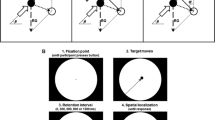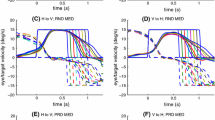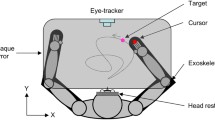Summary
A series of experiments has been conducted on human subjects to examine the effect of the movement of small targets located in the peripheral visual field on oculomotor response. Subjects were presented with either a single centrally positioned target or a pair of targets displaced at angles of ±5°, ±10° and ±20° from centre. Target movement was in the horizontal plane, the paired targets always moving in unison. The stimulus waveform consisted of either a sinusoidal or random target motion encompassing a frequency range from 0.1 to 4 Hz with an angular displacement of ±3.5°. Subjects made two types of response. First they were instructed to follow the single target or the centre point of the paired targets. In this ‘active’ pursuit condition the gain of slow-phase eye velocity progressively decreased as the moving targets were moved from the central position to the most peripheral location (±20°). Secondly, subjects were required passively to ignore the target movement by staring blankly ahead. During this ‘passive’ response nystagmic eye movements were induced for which the slowphase eye velocity also decreased with increasing target eccentricity, but the gains were always less than those induced during ‘active’ pursuit. The frequency characteristics of the ‘passive’ response were very similar to those of the ‘active’ response, breaking down at frequencies beyond 1 Hz. The ability to suppress the ‘passive’ response was also investigated by the presentation of a tachistoscopically illuminated earth-fixed target. The response was found to decline as the interval between presentations of the fixation target was decreased from 3000 ms to 100 ms. It is suggested that the ‘passive’ response originates from a basic velocity drive to the oculomotor system resulting from image movement across the retina. This velocity drive may be cancelled with adequate fixation but must be enhanced to accomplish desired eye velocity during active pursuit.
Similar content being viewed by others
References
Barnes GR (1982a) A procedure for the analysis of nystagmus and other eye movements. Aviat Space Environ Med 53 (7): 676–682
Barnes GR (1982b) The effects of retinal location and strobe rate of head-fixed visual targets on suppression of vestibular nystagmus. In: Roucoux A, Crommelinck M (eds) Physiological and pathological aspects of eye movements. Dr. W Junk Publishers, The Hague, pp 281–300
Barnes GR (1983) The effects of retinal target location on suppression of the vestibulo-ocular reflex. Exp Brain Res 49: 257–268
Barnes GR (1984) The effects of ethyl alcohol on visual pursuit and suppression of the vestibulo-ocular reflex. Acta Otolaryng Suppl 406: 161–166
Barnes GR, Benson AJ, Prior ARJ (1978) Visual-vestibular interaction in the control of eye movement. Aviat Space Environ Med 49: 557–564
Barnes GR, Edge A (1983) Non-linear effects in suppression of vestibular nystagmus. Exp Brain Res 52: 9–19
Behrens F, Grusser O-J (1979) Smooth pursuit eye movements and optokinetic nystagmus elicited by intermittently illuminated stationary patterns. Exp Brain Res 37: 317–336
Benson AJ, Barnes GR (1978) Vision during angular oscillation: The dynamic interaction of visual and vestibular mechanisms. Aviat Space Environ Med 49: 340–345
Cheng M, Outerbridge JS (1975) Optokinetic nystagmus during selective retinal stimulation. Exp Brain Res 23: 129–139
Collewijn H, Conijn P, Martins AJ, Tamminga EP, van Die GC (1982) Control of gaze in man: Synthesis of pursuit, optokinetic and vestibulo-ocular systems. In: Roucoux A, Crommelinck M (eds) Physiological and pathological aspects of eye movements. Dr. W. Junk, The Hague, pp 3–22
Dallos PJ, Jones RW (1963) Learning behaviour of the eye fixation control system. IEEE Trans Automat Control AC-A, 218–227
Dubois MFW, Collewijn H (1979) Optokinetic reactions in man elicited by localized retinal motion stimuli. Vision Res 19: 1105–1115
Eckmiller R (1981) A model of the Neural network controlling foveal pursuit eye movements. In: Fuchs AF, Becker W (eds) Progress in oculomotor research. Elsevier, North Holland, pp 541–550
Fender DH, Nye PW (1961) An investigation of the mechanisms of eye movement control. Kybernetik 1: 81–88
Heywood S, Churcher J (1971) Eye movements and the after image. 1. Tracking the after image. Vision Res 11: 1163–1168
Kommerell G, Taumer R (1972) Investigations of the eye tracking system through stabilized retinal images. In: Dichgans J, Bizzi E (eds) Cerebral control of eye movements and motion perception. Karger, Basel, pp 288–297
Lisberger SG, Fuchs AF (1978) Role of primate flocculus during rapid behavioural modification of vestibulo-ocular reflex. I. Purkinje cell activity during visually guided horizontal smooth-pursuit eye movements and passive head rotation. J Neurophysiol 41: 733–763
Miles FA, Lisberger SG (1981) Plasticity in the vestibulo-ocular reflex: A new hypothesis. Ann Rev Neurosci 4: 273–299
Michalski A, Kossut M, Zernicki B (1977) The ocular following reflex elicited from the retinal periphery in the cat. Vision Res 17: 713–736
Pola J, Wyatt HJ (1980) Target position and velocity: The stimuli for smooth pursuit eye movements. Vision Res 20: 523–534
Raphan T, Matsuo V, Cohen B (1979) Velocity storage in the vestibulo-ocular arc. Exp Brain Res 35: 229–248
Rashbass C (1961) The relationship between saccadic and smooth tracking eye movements. J Physiol 159: 338–362
Robinson DA (1965) The mechanics of human smooth pursuit eye movement. J Physiol 180: 569–591
Robinson DA (1982) A model of cancellation of the vestibuloocular reflex. In: Lennestrand G, Zee DS, Keller EL (eds) Functional basis of ocular motility disorders. Pergamon, Oxford, pp 5–13
Stark L (1971) The control system for versional eye movements. In: Bach-y-Rita P et al. (eds) The control of eye movements. Academic Press, New York, pp 363–428
Steinbach MJ (1976) Pursuing the perceptual rather than the retinal stimulus. Vision Res 16: 1371–1376
Steinman RB, Skavenski AA, Sansbury RV (1969) Voluntary control of smooth pursuit velocity. Vision Res 1167–1171
Ter Braak JWG (1936) Untersuchungen über optokinetischen Nystagmus. Arch Neerl Physiol 21: 309–376
Waespe W, Büttner U, HennV (1981) Input-output activity of the primate flocculus during visual-vestibular interaction. In: Cohen B (ed) Vestibular and oculomotor physiology. Ann NY Acad Sci 374: 491–503
Winterson BJ, Steinman RM (1978) The effect of luminance on human smooth pursuit of perifoveal and foveal targets. Vision Res 18: 1165–1172
Wyatt HJ, Pola J (1979) The role of perceived motion in smooth pursuit eye movements. Vision Res 19: 613–618
Yasui S, Young LR (1975) Perceived visual motion as effective stimulus to pursuit eye movement system. Science 190: 906–908
Young LR (1971) Pursuit eye tracking movements. In: Bach-y-Rita et al. (ed) The control of eye movements. Academic Press, New York London, pp 429–443
Young LR (1977) Pursuit eye movement — what is being pursued? In: Baker R, Berthoz A (eds) Control of gaze by brain stem neurons. Developments in neuroscience, Vol 1, pp 29–36. Elsevier, North Holland
Young LR, Stark L (1963) Variable feedback experiments testing a sampled data model for eye tracking movements. IEEE Trans HFE-4: 28–51
Author information
Authors and Affiliations
Rights and permissions
About this article
Cite this article
Barnes, G.R., Hill, T. The influence of display characteristics on active pursuit and passively induced eye movements. Exp Brain Res 56, 438–447 (1984). https://doi.org/10.1007/BF00237984
Received:
Accepted:
Issue Date:
DOI: https://doi.org/10.1007/BF00237984




